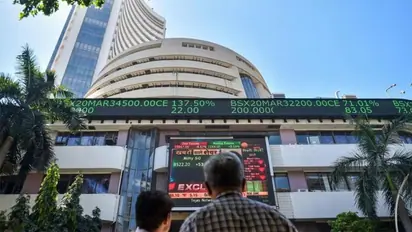What caused Rs 6 lakh crore market meltdown on Dalal Street

Synopsis
The Indian stock market experienced a significant downturn as both the BSE Sensex and Nifty50 indices plunged, with the latter dropping below the crucial 22,000 mark. This sell-off extended to midcaps, smallcaps, and microcap segments, resulting in substantial losses for investors.
The Indian stock market witnessed a sharp downturn on Wednesday, with both the BSE Sensex and Nifty50 indices taking a significant hit. The Nifty50 index plummeted below the critical 22,000 mark, while the BSE Sensex, a broader indicator of market performance, nosedived by approximately 800 points or 1%, reaching a low of 72,300.
The sell-off extended beyond the major indices, impacting midcaps, smallcaps, and microcap segments, all experiencing a substantial decline of around 2%. This downward spiral led to investors on Dalal Street collectively losing an estimated Rs 6 lakh crore, as the overall market capitalization of BSE-listed stocks dwindled to Rs 386 lakh crore, according to insights from an Economic Times report.
Previously, the Nifty had been exhibiting a sideways movement in what seemed like a consolidation phase. However, its consistent closure above the crucial 22,000 level for eight consecutive sessions hinted at a positive market trend. Nevertheless, technical analysts are now expressing concerns that if the index fails to sustain its position above 22,000, it could trigger further downward pressure.
Several factors contributed to the dramatic market downturn:
Sebi's Intervention: The Securities and Exchange Board of India (Sebi) intervened in response to the escalating prices of smallcaps and midcaps, issuing directives to mutual funds to provide more detailed information about the associated risks in these segments. This move, aimed at addressing liquidity challenges, requires mutual funds to disclose crucial details such as the time required to accommodate large redemptions and the potential impact of significant outflows on portfolio value.
US Federal Reserve's Stance: Investors were eagerly awaiting the release of the US personal consumption expenditures price index (PCE) data for January, as it could influence the Federal Reserve's decisions regarding interest rate hikes. The probability of a rate cut in the June meeting has diminished to 59%, as indicated by the CME Group's FedWatch tool.
Valuation Concerns: Growing unease among investors stemmed from the market cap-to-GDP ratio surpassing 120%, signalling potentially inflated valuations, particularly in the broader market. Despite the conclusion of the December quarter earnings season, expectations for fiscal year 2025 have shown minimal changes.
Global Market Trends: The decline in MSCI's broadest index of Asia-Pacific shares, excluding Japan, coupled with dips in Japan's benchmark Nikkei 225 and indices in Hong Kong and Shanghai, contributed to the overall bearish sentiment.
Monthly F&O Expiry Influence: Market volatility was exacerbated by the upcoming monthly Futures and Options (F&O) expiry scheduled for tomorrow. Analysts noted significant open interest levels, indicating potential support and resistance levels for the index.
Profit-Taking vs. Retail Investments: Recent market sentiment has seen conflicting trends, with some investors opting to book profits while others continue to inject capital into the market. This dynamic has added to the overall volatility and uncertainty.
Stay updated with all the latest Business News, including market trends, Share Market News, stock updates, taxation, IPOs, banking, finance, real estate, savings, and investments. Track daily Gold Price changes, updates on DA Hike, and the latest developments on the 8th Pay Commission. Get in-depth analysis, expert opinions, and real-time updates to make informed financial decisions. Download the Asianet News Official App from the Android Play Store and iPhone App Store to stay ahead in business.